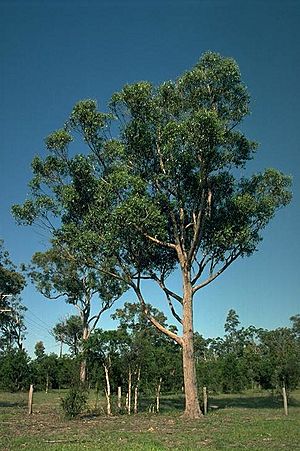Camfield's stringybark facts for kids
Quick facts for kids Camfield's stringybark |
|
|---|---|
 |
|
| Eucalyptus camfieldii near Wyong | |
| Conservation status | |
| Scientific classification | |
| Genus: |
Eucalyptus
|
| Species: |
camfieldii
|
Camfield's stringybark, also called heart-leaved stringybark, is a special kind of eucalyptus tree. It's usually a small tree or a "mallee," which means it has many stems growing from the ground. This plant only grows naturally in New South Wales, Australia. It has rough, stringy bark, long leaves, white flowers, and unique flat, round fruits. You can find it growing in sandy soil around the Sydney area.
Contents
What Does Camfield's Stringybark Look Like?
Camfield's stringybark is usually a mallee, growing up to 4 meters (about 13 feet) tall. Sometimes, it can be a taller, straggly tree, reaching up to 10 meters (about 33 feet). It has a special woody lump at its base called a lignotuber, which can be as wide as 20 meters (about 66 feet)! Many stems grow from this lignotuber.
The bark of this tree is grey or brownish, rough, and stringy. Young plants and new shoots have heart-shaped or nearly round leaves. These leaves are about 25 to 42 millimeters (1 to 1.7 inches) long. Adult leaves are shaped like a wide spear, shiny green on both sides. They are about 60 to 110 millimeters (2.4 to 4.3 inches) long.
The flowers grow in groups of nine to fifteen. They are found where the leaves join the stem. Each group of flowers grows on a flattened stalk about 5 to 10 millimeters (0.2 to 0.4 inches) long. The flower buds themselves don't have individual stalks. Mature buds are oval-shaped, about 6 to 10 millimeters (0.2 to 0.4 inches) long.
This plant mainly flowers from August to November, and its flowers are white. After flowering, the tree produces woody, flattened, round fruits. These fruits are crowded together and are about 4 to 5 millimeters (0.16 to 0.2 inches) long.
How Was It Named?
The Camfield's stringybark was first officially described in 1920. A scientist named Joseph Maiden wrote about it in a science journal. He found a sample of the plant near Middle Harbour in Sydney.
The "camfieldii" part of its scientific name honors Julius Henry Camfield. He worked at the Royal Botanic Garden, Sydney for many years, from 1882 until 1916.
Where Does It Grow?
Camfield's stringybark only grows in a specific part of New South Wales. You can find it on sandy ridges and some coastal headlands. It grows in poor, shallow sandy soil. Its natural home stretches from Norah Head down to Waterfall.
Is It Endangered?
Yes, Camfield's stringybark is considered "vulnerable." This means it's at risk of disappearing if we don't protect it. Both the Australian Government and the New South Wales Government have laws to protect it.
The main reasons this plant is in danger are:
- Habitat Loss: Its natural areas are being cleared for building and other uses.
- Fire: The wrong types of bushfires can harm the plants.
- Weeds: Invasive weeds can take over its habitat and outcompete it.
Images for kids




